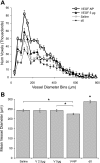Sustained VEGF delivery via PLGA nanoparticles promotes vascular growth
- PMID: 20228260
- PMCID: PMC2886627
- DOI: 10.1152/ajpheart.00199.2009
Sustained VEGF delivery via PLGA nanoparticles promotes vascular growth
Abstract
Technologies to increase tissue vascularity are critically important to the fields of tissue engineering and cardiovascular medicine. Currently, limited technologies exist to encourage angiogenesis and arteriogenesis in a controlled manner. In the present study, we describe an injectable controlled release system consisting of VEGF encapsulated in poly(lactic-co-glycolic acid) (PLGA) nanoparticles (NPs). The majority of VEGF was released gradually over 2-4 days from the NPs as determined by an ELISA release kinetics experiment. An in vitro aortic ring bioassay was used to verify the bioactivity of VEGF-NPs compared with empty NPs and no treatment. A mouse femoral artery ischemia model was then used to measure revascularization in VEGF-NP-treated limbs compared with limbs treated with naked VEGF and saline. 129/Sv mice were anesthetized with isoflurane, and a region of the common femoral artery and vein was ligated and excised. Mice were then injected with VEGF-NPs, naked VEGF, or saline. After 4 days, three-dimensional microcomputed tomography angiography was used to quantify vessel growth and morphology. Mice that received VEGF-NP treatment showed a significant increase in total vessel volume and vessel connectivity compared with 5 microg VEGF, 2.5 microg VEGF, and saline treatment (all P < 0.001). When the yield of the fabrication process was taken into account, VEGF-NPs were over an order of magnitude more potent than naked VEGF in increasing blood vessel volume. Differences between the VEGF-NP group and all other groups were even greater when only small-sized vessels under 300 mum diameter were analyzed. In conclusion, sustained VEGF delivery via PLGA NPs shows promise for encouraging blood vessel growth in tissue engineering and cardiovascular medicine applications.
Figures





Similar articles
-
Combined effects of PLGA and vascular endothelial growth factor promote the healing of non-diabetic and diabetic wounds.Nanomedicine. 2015 Nov;11(8):1975-84. doi: 10.1016/j.nano.2015.07.006. Epub 2015 Jul 31. Nanomedicine. 2015. PMID: 26238081
-
Sustained delivery of vascular endothelial growth factor using a dextran/poly(lactic-co-glycolic acid)-combined microsphere system for therapeutic neovascularization.Heart Vessels. 2019 Jan;34(1):167-176. doi: 10.1007/s00380-018-1230-5. Epub 2018 Jul 24. Heart Vessels. 2019. PMID: 30043157
-
Sustained vascular endothelial growth factor delivery enhances angiogenesis and perfusion in ischemic hind limb.Pharm Res. 2005 Jul;22(7):1110-6. doi: 10.1007/s11095-005-5644-2. Epub 2005 Jul 22. Pharm Res. 2005. PMID: 16028011
-
Controlled delivery of vascular endothelial growth factor promotes neovascularization and maintains limb function in a rabbit model of ischemia.J Vasc Surg. 1998 May;27(5):886-94; discussion 895. doi: 10.1016/s0741-5214(98)70269-1. J Vasc Surg. 1998. PMID: 9620141
-
Therapeutic angiogenesis by local sustained release of microRNA-126 using poly lactic-co-glycolic acid nanoparticles in murine hindlimb ischemia.J Vasc Surg. 2018 Oct;68(4):1209-1215. doi: 10.1016/j.jvs.2017.08.097. Epub 2017 Dec 11. J Vasc Surg. 2018. PMID: 29242072
Cited by
-
Rebuilding the Vascular Network: In vivo and in vitro Approaches.Front Cell Dev Biol. 2021 Apr 21;9:639299. doi: 10.3389/fcell.2021.639299. eCollection 2021. Front Cell Dev Biol. 2021. PMID: 33968926 Free PMC article. Review.
-
Nanoparticles Targeting the Molecular Pathways of Heart Remodeling and Regeneration.Pharmaceutics. 2022 Mar 26;14(4):711. doi: 10.3390/pharmaceutics14040711. Pharmaceutics. 2022. PMID: 35456545 Free PMC article. Review.
-
Oxygen and nutrient delivery in tissue engineering: Approaches to graft vascularization.J Tissue Eng Regen Med. 2019 Oct;13(10):1815-1829. doi: 10.1002/term.2932. Epub 2019 Jul 30. J Tissue Eng Regen Med. 2019. PMID: 31310055 Free PMC article. Review.
-
Calcium-alginate hydrogel-encapsulated fibroblasts provide sustained release of vascular endothelial growth factor.Tissue Eng Part A. 2013 Apr;19(7-8):905-14. doi: 10.1089/ten.TEA.2012.0197. Epub 2012 Dec 7. Tissue Eng Part A. 2013. PMID: 23082964 Free PMC article.
-
Nanoscale strategies: treatment for peripheral vascular disease and critical limb ischemia.ACS Nano. 2015;9(4):3436-52. doi: 10.1021/nn507269g. Epub 2015 Apr 10. ACS Nano. 2015. PMID: 25844518 Free PMC article. Review.
References
-
- Davda J, Labhasetwar V. Characterization of nanoparticle uptake by endothelial cells. Int J Pharm 233: 51–59, 2002 - PubMed
-
- Duvall CL, Taylor WR, Weiss D, Guldberg RE. Quantitative microcomputed tomography analysis of collateral vessel development after ischemic injury. Am J Physiol Heart Circ Physiol 287: H302–H310, 2004 - PubMed
-
- Duvall CL, Weiss D, Robinson ST, Alameddine FM, Guldberg RE, Taylor WR. The role of osteopontin in recovery from hind limb ischemia. Arterioscler Thromb Vasc Biol 28: 290–295, 2008 - PubMed
-
- Freedman SB, Isner JM. Therapeutic angiogenesis for coronary artery disease. Ann Intern Med 136: 54–71, 2002 - PubMed
Publication types
MeSH terms
Substances
Grants and funding
LinkOut - more resources
Full Text Sources
Other Literature Sources
Miscellaneous

